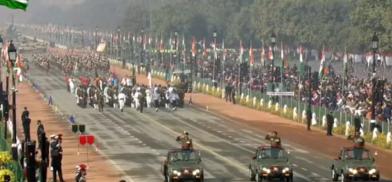India displays military might, diversity at R-Day parade; Bangladesh contingent leads parade
India's military might, cultural diversity, social and economic progress were displayed during the 72nd Republic Day celebrations at the majestic Rajpath in New Delhi on Tuesday

India's military might, cultural diversity, social and economic progress were displayed during the 72nd Republic Day celebrations at the majestic Rajpath in New Delhi on Tuesday.
The widely popular song "Shono ekti Mujiborer theke/Lokkho Mujiborer" played by the Bangladesh military band resonated across Rajpath as the country's armed forces contingent participated for the first time in the parade to honour 50 years of Bangladesh's independence. The Bangladesh contingent carried the legacy of legendary Muktijoddhas of Bangladesh, who fought against oppression and mass atrocities and liberated Bangladesh in 1971.
The song, played by the band troupe headed by Lt Col Abu Mohd Shahnoor Shawan, was applauded by hundreds of viewers of the parade.
The Bangladesh military band was followed by a 122-member defence forces team, comprising the army, air force and navy, whose impressive march-past was appreciated by the spectators.
According to India Strategic, it didn’t matter that the pandemic had curtailed the parade in many ways, shortening it to some two kilometres against the normal 10-plus, or that the size of the marching contingents had been reduced to 96 from 144, or that the veterans who had won gallantry awards were not on view, or that the stunt displays by motorcycle-borne Daredevils were missing or that the spectators on Rajpath were restricted to 25,000 against the normal 150,000, because there were many firsts.
On view were the rapid strides made in home-grown defence technologies, including the fourth generation-plus Tejas light combat aircraft (LCA) that has finally come of age with an order for 83 planes being cleared by the government in the largest indigenous defence deal so far at $6.5 billion, a range of ATGMs (Anti-Tank Guided Missiles), a New Generation surface-to-air missile, a mobile autonomous launcher for the BrahMos supersonic cruise missile and an electronic warfare system.
The indigenously-developed Arjun Main Battle Tank, the T-90 Bhishma, Infantry Combat Vehicle (ICV) Ballway Machine Pikate (BMP II), Brahmos Weapon System, T-72 bridge-laying tanks, the Samvijay electronic warfare system and the Schilka weapon system were the main attractions of the mechanised columns.
Next was one of the most-awaited attractions of the event, one Rafale with two Jaguar deep penetration strike aircraft and two MiG-29s in ‘Vic’ formation at a height of 300 metres and a speed of 780 kilometres per hour. This was followed by the Trinetra formation comprising three Su-30MKIs, while the penultimate Vijay formation comprised three Advanced Light Helicopters which are part of the IAF’s acclaimed Sarang Display Team.
The culmination was a single Rafale flying at a speed of 900 kilometres per hour and carrying out a ‘Vertical Charlie’ as it pulled up sharply and vanished into the sky. The aircraft was piloted by Group Captain Harkirat Singh, Commanding Officer of 17 Squadron, which is the first to induct the Rafale, with Squadron Leader Kislaykant. As it shot up, the aircraft performed a series of rolls in a befitting salute to the IAF motto of ‘Nabha Sparshan Deeptam’.









Post a Comment